Insect-inspired mechatronics : the pervasive impact of ecological and evolutionary forces in the development of microsensors development
Using, among others, our work on both the air flow sensing hairs of insects and the development of MEMS (Micro-Electronical-Mechanical-Systems) sensors, as well as on olfaction (mainly in insects with complex antennae), I will show how the constant dialogue between engineers and biologists towards to production of artefacts is profoundly affected by the uncertain, oftentimes unknown but key ecological and evolutionary forces acting on the structure and the organism. While engineers might work around clearly defined figures of merit for the man-made artefact, biologists are working backward, guessing the figure of merit of the basis of the observed properties of the natural system. Even the optimization approach taken by Nature is unknown to them: maximizing, optimizing or satisfying? Furthermore, biologists have to take into account its integration in a larger system on which natural selection acts: the organism. I will discuss the implications of these different sets of conditions, in particular for engineers, who need to know when it is time to give up on getting inspiration from biology and using other approaches for achieving better performance.
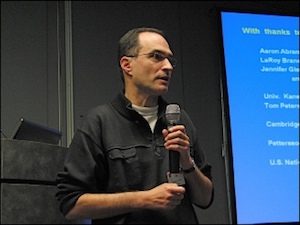 Jérôme Casas obtained his Ph.D. from the ETH Zurich in 1989. After a short post-doc at Strathclyde University (Glasgow) he became an assistant professor (Oberassistant) at the ETH Zurich. In 1993, moved to the University of California, Santa Barbara, and returned to Europe as full Professor in 1995 in Tours. His research interests span physiology and ecology, including work on the physical ecology of insects; the physiology, behavior and population dynamics of consumer-resource interactions; the sensory ecology of mimetism; and biologically-inspired technology, particularly biomimetic flow sensing. One notable feature of his approach is the blending of natural history with both state-of-the-art technology and modeling. He contributes to many national and international scientific boards, the most notable being BIOKON-The International Biomimetics Association (Berlin), the governing board of the FRB (Fondation sur la Recherche en Biodiversité, previously IFB, Paris), as well as the interdisciplinary committee of the Canada Research Chairs program (Ottawa).
Jérôme Casas obtained his Ph.D. from the ETH Zurich in 1989. After a short post-doc at Strathclyde University (Glasgow) he became an assistant professor (Oberassistant) at the ETH Zurich. In 1993, moved to the University of California, Santa Barbara, and returned to Europe as full Professor in 1995 in Tours. His research interests span physiology and ecology, including work on the physical ecology of insects; the physiology, behavior and population dynamics of consumer-resource interactions; the sensory ecology of mimetism; and biologically-inspired technology, particularly biomimetic flow sensing. One notable feature of his approach is the blending of natural history with both state-of-the-art technology and modeling. He contributes to many national and international scientific boards, the most notable being BIOKON-The International Biomimetics Association (Berlin), the governing board of the FRB (Fondation sur la Recherche en Biodiversité, previously IFB, Paris), as well as the interdisciplinary committee of the Canada Research Chairs program (Ottawa).
Bio-Inspired and Bio-Hybrid Miniature Mobile Robots
Small-scale untethered mobile robots have the unique capability of accessing to small spaces and scales directly. Due to their small size and small-scale physics and dynamics, they could be agile and portable, and could be inexpensive and in large numbers if they are mass-produced. They would have high-impact applications in health-care, bioengineering, environment monitoring, and inspection. In this talk, two approaches are presented to design new mobile milli/microrobots. First, bio-inspiration from small-scale soft-bodied organisms, such as caterpillars, jellyfishes, and insect larvae, is used to create soft-bodied millirobots with multimodal locomotion capability. Using magnetoelastic composite soft active materials and remote magnetic actuation, soft millirobots are proposed, which can swim, climb on water meniscus, walk, crawl, jump, roll, and transit from liquid to solid surfaces (and vice versa), and can also carry and release cargo via their active dynamic shape control. Next, bio-hybrid approach (integrating biological cells with synthetic materials) is used to create bacteria-driven microswimmers. One or multiple genetically engineered E. coli bacteria are attached to synthetic or biological cargo carriers, such as polyelectrolyte multilayer microparticles, double microemulsions, microtubes, and red blood cells, which include drugs, genes, or imaging agents as their cargo and magnetic nanoparticles for their guidance control. Such bio-hybrid microswimmers are steered using remote magnetic fields and chemical, oxygen or pH gradients in a given physiological microenvironment. In vitro targeted active cargo delivery demonstrations of such microswimmers are reported toward targeted cancer therapy type of medical applications.
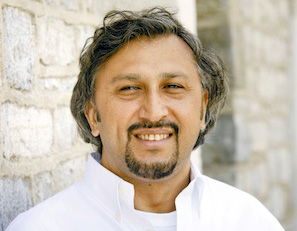 Metin Sitti received the BSc and MSc degrees in electrical and electronics engineering from Bogazici University, Turkey, in 1992 and 1994, respectively, and the PhD degree in electrical engineering from the University of Tokyo, Japan, in 1999. He was a research scientist at UC Berkeley during 1999-2002. He was a professor at Carnegie Mellon University in USA during 2002-2016. Since 2014, he has been a director in Max Planck Institute for Intelligent Systems in Stuttgart, Germany. His research interests include physical intelligence, mobile milli/microrobots, soft robots, and bio-inspired robotic materials and locomotion. He is an IEEE Fellow. He received the SPIE Nanoengineering Pioneer Award in 2011 and NSF CAREER Award in 2005. He received many best paper and video awards in major robotics and adhesion conferences. He is the editor-in-chief of Journal of Micro-Bio Robotics.
Metin Sitti received the BSc and MSc degrees in electrical and electronics engineering from Bogazici University, Turkey, in 1992 and 1994, respectively, and the PhD degree in electrical engineering from the University of Tokyo, Japan, in 1999. He was a research scientist at UC Berkeley during 1999-2002. He was a professor at Carnegie Mellon University in USA during 2002-2016. Since 2014, he has been a director in Max Planck Institute for Intelligent Systems in Stuttgart, Germany. His research interests include physical intelligence, mobile milli/microrobots, soft robots, and bio-inspired robotic materials and locomotion. He is an IEEE Fellow. He received the SPIE Nanoengineering Pioneer Award in 2011 and NSF CAREER Award in 2005. He received many best paper and video awards in major robotics and adhesion conferences. He is the editor-in-chief of Journal of Micro-Bio Robotics.
From insect perception to robot and vice versa
The Biorobotic approach is a meeting point where robotics and neuroscience are used to try to explain the behaviour of animals, especially winged insects (fly, bee, wasp...) and to model the processing of the sensory modalities at work in these outstanding animals. The neurophysiology is also used to better understand the sensorimotor reflexes at work in insects. The robots are a kind of embodiment of this insect-based knowledge to validate our models. Recent studies carried out at our laboratory focused on: the graviception in fly, i.e., the ability of the animal to assess its orientation with respect to gravity and ant-inspired navigation strategies by means of a celestial compass. Would it be possible that a fly, able to achieve exquisite manoeuvres, could not have any clue of its body tilt with respect to gravity during flight? Could future robotic applications take a great benefit of the skylight polarization? Several bio-inspired visuals sensors, as well as bio-inspired robots, will be presented in this talk
 Stéphane Viollet, is a CNRS researcher director at the Institute of Movement Sciences, Aix-Marseille Université and head of the Biorobotics team. He received the master’s degree in control engineering from the University of Bordeaux 1, France, and the Ph.D. degree from the National Polytechnic Institute, Grenoble, France, in September 2001. He obtained a CNRS permanent position in 2003. His interests include sensory-motor reflexes in flies, retinal micro- movements and bio-inspired control strategies for aerial robots. He is the leader of the development of autonomous robots and innovative visual sensors for robotics (artificial compound eye, hyperacute sensors, and artificial retinas) and involved in several national and European projects on these topics. He is the author of more than 60 publications, 8 patents, and recipient of several best paper awards and nominations (Journal La Recherche in 2005, IEEE ICAR, IEEE Sensors and Living Machines conf.).
Stéphane Viollet, is a CNRS researcher director at the Institute of Movement Sciences, Aix-Marseille Université and head of the Biorobotics team. He received the master’s degree in control engineering from the University of Bordeaux 1, France, and the Ph.D. degree from the National Polytechnic Institute, Grenoble, France, in September 2001. He obtained a CNRS permanent position in 2003. His interests include sensory-motor reflexes in flies, retinal micro- movements and bio-inspired control strategies for aerial robots. He is the leader of the development of autonomous robots and innovative visual sensors for robotics (artificial compound eye, hyperacute sensors, and artificial retinas) and involved in several national and European projects on these topics. He is the author of more than 60 publications, 8 patents, and recipient of several best paper awards and nominations (Journal La Recherche in 2005, IEEE ICAR, IEEE Sensors and Living Machines conf.).
The Mechanical Dreams of Leonardo da Vinci: From sketches to machines
As such bio inspiration is not totally an invention of our present; in the Renaissance, engineers looked at natural shapes and were convinced that mimicking nature offered technical solutions to their own problems. Around 1580, Mathew Baker, for instance, a Tudor shipbuilder, produced the drawing of a galleon hull about to transform itself into a giant fish and Maximilian armours, with their decorative fluting, offered strange similarities with the belly of a Rhinoceros drawn by Albrecht Dürer. Nevertheless, Leonardo da Vinci was certainly the most careful observer of nature of his time and as a result, it has become a common evidence to assess that he was using biomimetism as a way to find inspiration. Recently, for an exhibition at the Cité des Sciences in La Villette, scientists claimed that Leonardo was some kind of precursor for bionics. The exhibition displayed different kinds of
animatronics like an elephant trump, a robot-gecko, a robot-lobster or a robot-insect and showed posters about the property of squale-skin or bee-hives alveolas. The intellectual process of imitation adopted by Leonardo da Vinci was however not fully investigated. Pascal Brioist’s paper proposes to get deeper into this enquiry looking especially at the imitation of birds, bats, insects and flying fishes to study the possibilities of flying available to humans. Leonardo’s notes on comparative anatomy had practical aim but their complexity gives us hints about the very singular ambition of his approach.
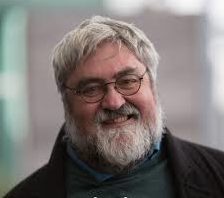 Pascal Brioist was born in 1962, he is associate of History, Professor of History Universities and member of CESR since 1994. Specialist in Cultural History and History of England (Ph.D. of the European University Institute of Florence in 1992): currently his works concern mainly the field of history of science and technology. Member since 1995 of the steering committee of the French Society of History of Sciences and Techniques. Co-author with Hervé Drévillon and Pierre Serna of a book on the history of sword violence, Croiser le Fer (2002); He also wrote two books for CAPES and Aggregation competitions: The Renaissance 1470-1570 and The Europeans and Maritime Spaces in the 18th Century. He published several articles relating to the intellectual and scientific history of the Renaissance and in 2002 he realized the scientific conception of the Leonardo da Vinci Park at Clos-Lucé in Amboise. He is currently working on the Renaissance website, which is shared by CNED and CESR
Pascal Brioist was born in 1962, he is associate of History, Professor of History Universities and member of CESR since 1994. Specialist in Cultural History and History of England (Ph.D. of the European University Institute of Florence in 1992): currently his works concern mainly the field of history of science and technology. Member since 1995 of the steering committee of the French Society of History of Sciences and Techniques. Co-author with Hervé Drévillon and Pierre Serna of a book on the history of sword violence, Croiser le Fer (2002); He also wrote two books for CAPES and Aggregation competitions: The Renaissance 1470-1570 and The Europeans and Maritime Spaces in the 18th Century. He published several articles relating to the intellectual and scientific history of the Renaissance and in 2002 he realized the scientific conception of the Leonardo da Vinci Park at Clos-Lucé in Amboise. He is currently working on the Renaissance website, which is shared by CNED and CESR
Memory Mechanisms in Man and Machine
Thanks to an ERC Advanced Grant, we have spent the past 5 years exploring a number of radical ideas about how the brain stores very long-term sensory memories for visual and auditory stimuli - memories that can allow us to instantly recognise a piece of music or a TV program that we may not have seen or heard for decades. I have proposed that such long-term memories involve the formation of highly selective neurones - effectively "Grandmother cells” - that will only fire if something close to the original stimulus is presented. We suggest that the key to forming these highly selective neurones is repetition - neurones will become selective to any new repeating stimulus that doesn’t activate other neurones. Furthermore, we propose that neocortex contains a sort of “Dark Matter” - a substantial proportion of neurones that are totally inactive and are simply waiting for the original stimulus used for training to reoccur (for example, that old TV program!). Interestingly, we have developed a new form of Spike-Time Dependent Plasticity rule (STDP) that allows this process to be reproduced in digital hardware, making it possible to develop artificial systems that function in the same way. In collaboration with BrainChip Inc, we are currently developing dedicated chips that should allow artificial systems to be developed that have millions of neurones and billions of synaptic connections and that could store very large numbers of sensory memories.
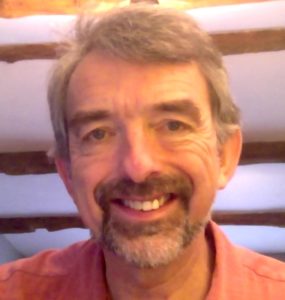 Simon Thorpe obtained a degree in Psychology, Philosophy & Physiology (PPP) from St Catherine's College Oxford in 1977. He stayed on to get his doctorate with Edmund Rolls in 1981. After a postdoc in Canada, he moved to France where he has been working as a CNRS researcher since 1983. He was a founding member of the CerCo (Brain & Cognition Research Centre) in Toulouse in 1993 and is now the Cerco's director. He is also the director of the Toulouse Mind & Brain Institute (tmbi.fr). Since the late 80s he has been arguing that even challenging problems like object and scene vision can be solved with a pure feed-forward architecture, a position vindicated by the recent success of convolutional neural networks and deep learning. He has also argued that spike-based processing is another feature of biological vision that can be used in artificial systems, a position that led him to create a bio-inspired vision company in 1999 – SpikeNet Technology.
Simon Thorpe obtained a degree in Psychology, Philosophy & Physiology (PPP) from St Catherine's College Oxford in 1977. He stayed on to get his doctorate with Edmund Rolls in 1981. After a postdoc in Canada, he moved to France where he has been working as a CNRS researcher since 1983. He was a founding member of the CerCo (Brain & Cognition Research Centre) in Toulouse in 1993 and is now the Cerco's director. He is also the director of the Toulouse Mind & Brain Institute (tmbi.fr). Since the late 80s he has been arguing that even challenging problems like object and scene vision can be solved with a pure feed-forward architecture, a position vindicated by the recent success of convolutional neural networks and deep learning. He has also argued that spike-based processing is another feature of biological vision that can be used in artificial systems, a position that led him to create a bio-inspired vision company in 1999 – SpikeNet Technology.
The control Architecture of Living Machines
Distributed Adaptive Control (DAC) is a theory of the design principles underlying the Mind, Brain, and Body Nexus (MBBN) that has been developed over the last 20 years. DAC assumes that the brain maintains stability between an embodied agent and its environment through action. It postulates that in order to act, or know how, the brain has to answer four fundamental questions: why, what, where, when. Thus the function of the brain is to continuously solve the so-called, H5W problem. The DAC theory is expressed as a robot based neural architecture organized in two complementary structures: layers and columns. The organizational layers are called: reactive, adaptive and contextual and its columnar organization defines the processing of states of the world, the self and the generation of action. Each layer is described with respect to its key hypotheses, implementation, and specific benchmarks. The adaptive layer will be analyzed in terms of the classical conditioning paradigm and its neuronal substrate the amygdala-cerebellum-neocortex complex together with episodic memory and the formation of sense-act couplets in the hippocampus. For the contextual layer the ability of circuits in the prefrontal cortex to acquire and express contextual plans for action is described. The general overview of DAC’s explanation of MBBN is combined by examples of application scenarios in which DAC has been validated including mobile and humanoid robots.
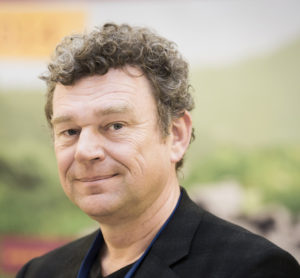 Paul Verschure is an ICREA Research Prof. at the Institute of Bioengineering of Catalonia where he runs the Laboratory of Synthetic Perceptive, Emotive and Cognitive Systems (SPECS). He received both his MA and PhD in Psychology and pursued his research at different leading institutes: the Neurosciences Institute and The Salk Institute, both in San Diego, the Univ. of Amsterdam, Univ. of Zurich and the Swiss Federal Institute of Technology-ETH and currently with ICREA and IBEC. Paul's research group comprises a multidisciplinary team of 25 doctoral and post-doctoral researchers including psychologists, engineers, and biologists. He is a consultant for the European Commission regarding the integration of Neuroinformatics in the 5th-6th & 7th FP, Horizon 2020 and a referee for Science, Nature, Royal Society London, Trends in Neuroscience, IEEE neural networks, PLoS Computational Biology and PLoS ONE.
Paul Verschure is an ICREA Research Prof. at the Institute of Bioengineering of Catalonia where he runs the Laboratory of Synthetic Perceptive, Emotive and Cognitive Systems (SPECS). He received both his MA and PhD in Psychology and pursued his research at different leading institutes: the Neurosciences Institute and The Salk Institute, both in San Diego, the Univ. of Amsterdam, Univ. of Zurich and the Swiss Federal Institute of Technology-ETH and currently with ICREA and IBEC. Paul's research group comprises a multidisciplinary team of 25 doctoral and post-doctoral researchers including psychologists, engineers, and biologists. He is a consultant for the European Commission regarding the integration of Neuroinformatics in the 5th-6th & 7th FP, Horizon 2020 and a referee for Science, Nature, Royal Society London, Trends in Neuroscience, IEEE neural networks, PLoS Computational Biology and PLoS ONE.
Science and Society session
Innovation, Outreach and Communication in Science using Superheroes
The superhero genre is now one of the most popular in modern cinema. Since the 2000 film X-Men, numerous superhero-themed films from Marvel Comics and DC Comics have been released. This year has seen the release of a number of films including Avengers: Infinity War, Deadpool 2 and Ant-Man and the Wasp featuring characters such as Black Widow, Deadpool, Iron Man and Spider-Man. As a measure of the popularity of the superhero film, the 2018 film Avengers: Infinity War has grossed more than $2 billion at the worldwide box office.
Given the current high profile of the superhero genre, it is tempting to utilise superheroes as a platform to bridge the gap between the academy and the general public and to inspire scientific research. Since 2015, I have been using superheroes in my scientific communication and outreach activities, leading to numerous talks and workshops for the general public, at schools and at universities. I have spoken at the Galway International Arts Festival, the International Film Festival Rotterdam, the Institute of Physics Frontiers of Physics and Dutch Comic Con on the subject of superheroes and the possibility of superpowers in the near future.
In this talk, I will introduce you to the world of superheroes, their origins and their films. Thereafter, I will explore the science behind some superhero
characters to demonstrate how superheroes can be used to explain scientific and engineering concepts. I will also present my academic research on superheroes via publications in peer-reviewed journals, the self-publishing of popular science books, writing online articles for BBC Science Focus Magazine and Futurism, and the establishment of an open-access journal – Superhero Science and Technology – at TU Delft.
References:
1) B.W. Fitzgerald, Secrets of Superhero Science, Eindhoven, The Netherlands, pg: 384, ISBN: 978-90-825040-0-2, 2016.
2) B.W. Fitzgerald, Secret Science of Santa Claus, Eindhoven, The Netherlands, pg: 296, ISBN: 978-90-825040-1-9, 2016.
3) B.W. Fitzgerald, Life Doesn’t Need to be a Drag for Iron Man, BBC Science Focus Magazine, 5 th September 2017. (http://www.sciencefocus.com/article/physics/life-really-doesn’t-need-be-drag-iron-man).
4) B.W. Fitzgerald, Using Hawkeye from the Avengers to communicate on the eye, Adv Physiol Educ 42: 90-98, 2018. doi: 10.1152/advan.00161.2017.
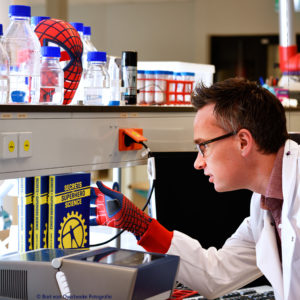
Barry W. Fitzgerald is a physicist and superhero enthusiast. He is currently a research associate in the Process & Energy department in the Faculty of Mechanical, Maritime and Materials Engineering (3mE) at the Technical University of Delft (TU Delft), the Netherlands.
In addition to his scientific research, Barry is very active in scientific communication and outreach. He has given hundreds of scientific talks in Ireland and the Netherlands at schools, universities, companies, and events such as Dutch Comic Con, Xmas Comic Con, Science Week Ireland, the Galway International Arts Festival, the International Film Festival Rotterdam, and the Delft International Festival of Technology. In February 2016, Barry self-published the popular science book Secrets of Superhero Science in which he outlines the real science and current scientific research that could be used to replicate the superpowers of a number of iconic superheroes. His follow-up book – Secret Science of Santa Claus – was published in October 2016. He has also published a number of scientific papers on innovative methods that can address communication and teaching using superheroes. In June 2017, Barry established the open access journal Superhero Science and Technology at TU Delft. The aim of the journal is to encourage researchers to link their research to the superhero genre and write articles in a language that is accessible to both the academic community and general public. The first papers were published in the journal in spring 2018. Barry views the superhero genre as a source of inspirational content for the development of a multitude of future advancements. He has seen the 2016 film Captain America: Civil War more than 35 times and his superpower will always remain a secret.
